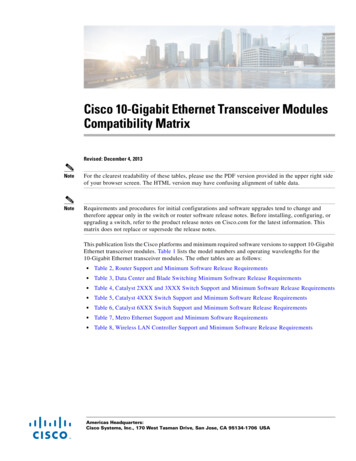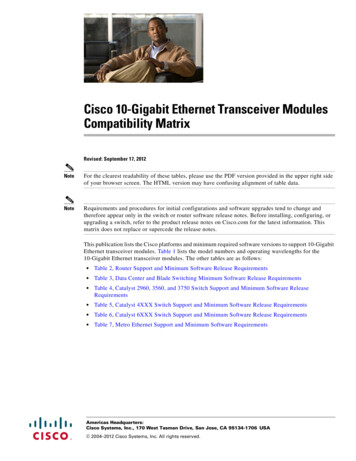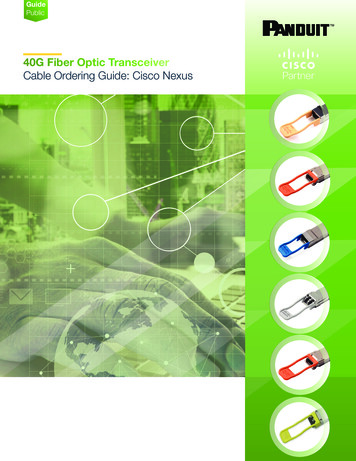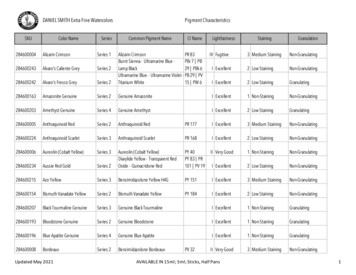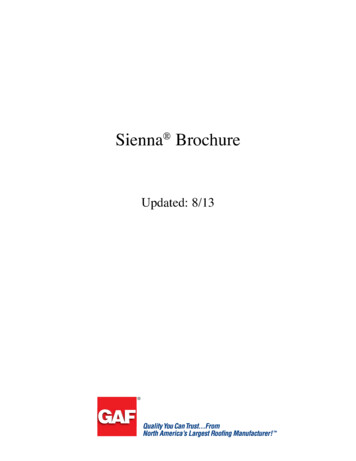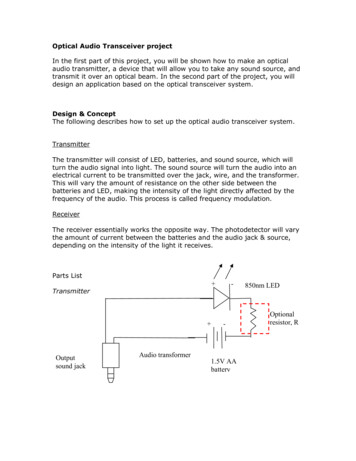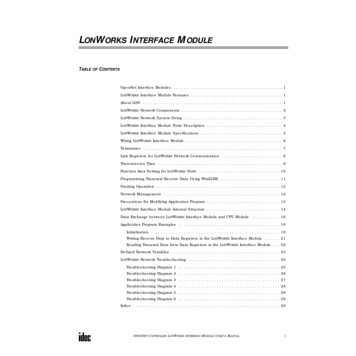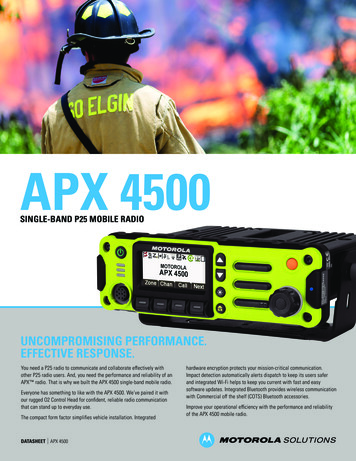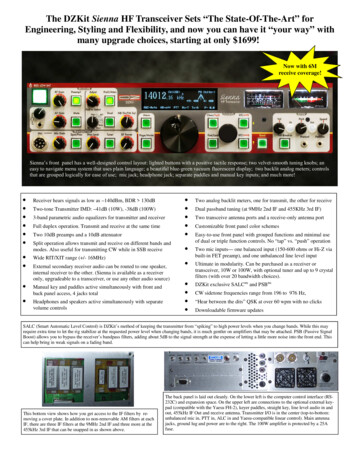
Transcription
The DZKit Sienna HF Transceiver Sets “The State-Of-The-Art” forEngineering, Styling and Flexibility, and now you can have it “your way” withmany upgrade choices, starting at only 1699!Now with 6Mreceive coverage!Sienna’s front panel has a well-designed control layout: lighted buttons with a positive tactile response; two velvet-smooth tuning knobs; aneasy to navigate menu system that uses plain language; a beautiful blue-green vacuum fluorescent display; two backlit analog meters; controlsthat are grouped logically for ease of use; mic jack; headphone jack; separate paddles and manual key inputs; and much more! Two 10dB preamps and a 10dB attenuator Split operation allows transmit and receive on different bands andmodes. Also useful for transmitting CW while in SSB receive Wide RIT/XIT range ( /- 16MHz) Receiver hears signals as low as –140dBm, BDR 130dBTwo-tone Transmitter IMD: –41dB (10W), -38dB (100W)3-band parametric audio equalizers for transmitter and receiverFull duplex operation. Transmit and receive at the same timeExternal secondary receiver audio can be routed to one speaker,internal receiver to the other. (Sienna is available as a receiveronly, upgradeable to a transceiver, or use any other audio source)Manual key and paddles active simultaneously with front andback panel access, 4 jacks totalHeadphones and speakers active simultaneously with separatevolume controls Two analog backlit meters, one for transmit, the other for receiveDual passband tuning (at 9MHz 2nd IF and 455KHz 3rd IF)Two transceive antenna ports and a receive-only antenna portCustomizable front panel color schemesEasy-to-use front panel with grouped functions and minimal useof dual or triple function controls. No “tap” vs. “push” operationTwo mic inputs— one balanced input (150-600 ohms or Hi-Z viabuilt-in FET preamp), and one unbalanced line level inputUltimate in modularity. Can be purchased as a receiver ortransceiver, 10W or 100W, with optional tuner and up to 9 crystalfilters (with over 20 bandwidth choices).DZKit exclusive SALCtm and PSBtmCW sidetone frequencies range from 196 to 976 Hz,“Hear between the dits” QSK at over 60 wpm with no clicksDownloadable firmware updatesSALC (Smart Automatic Level Control) is DZKit’s method of keeping the transmitter from “spiking” to high power levels when you change bands. While this mayrequire extra time to let the rig stabilize at the requested power level when changing bands, it is much gentler on amplifiers that may be attached. PSB (Passive SignalBoost) allows you to bypass the receiver’s bandpass filters, adding about 5dB to the signal strength at the expense of letting a little more noise into the front end. Thiscan help bring in weak signals on a fading band.This bottom view shows how you get access to the IF filters by removing a cover plate. In addition to non-removable AM filters at eachIF, there are three IF filters at the 9MHz 2nd IF and three more at the455kHz 3rd IF that can be snapped in as shown above.The back panel is laid out cleanly. On the lower left is the computer control interface (RS232C) and expansion space. On the upper left are connections to the optional external keypad (compatible with the Yaesu FH-2), keyer paddles, straight key, line level audio in andout, 455kHz IF Out and receive antenna. Transmitter I/O is in the center (top-to-bottom:unbalanced mic in, PTT in, ALC in and Yaesu-compatible linear control). Main antennajacks, ground lug and power are to the right. The 100W amplifier is protected by a 25Afuse.
Think you can’t have high performance in a kit radio? Think again!Sienna offers top-notch performance for the most demanding operators!World-class QSK! Hear between the dits at over 70 wpm. The toptrace above is the RF output at the antenna jack, with Siennasending two dits at 60 wpm. The bottom trace shows the Sidetone, and between the dits, received audio. You can see that thereceiver recovery time is only 10ms. Also note the “clickless”audio (no glitches in the waveform), and the smooth rise and falltime of the RF envelope.Sienna has up to 4 selectable IF filters at the 2nd IF, and 4 more at the3rd IF. Each IF can be “slid” back and forth against the other to effectively narrow the bandwidth. Above left, you can see the front paneldisplay with both filters centered and the resulting spectrum plot of asignal in the passband. On the right, one filter has been slid over200Hz, and you can see the resulting smaller bandwidth.Sienna Specifications. Frequency range: 10 kHz to 30 MHz. (Specs valid 1.8MHz-29.7MHz), 50-54 MHz receive Modes: SSB, CW, AM, FM and Digital (via externalPC). FM modulation: frequency modulated carrier with 2122 Hz pre-emphasis; selectable deviations of /-2, 4 and 5kHz. FM receive IF: 455kHz, includes two 4-pole /-10KHzceramic filters. MDS (PSB off): -115/-125/-134dBm (preamps off/1/2). MDS (PSB on): -120/-130/-135dBm (preamps off/1/2). BDR: 105dB at spacings greater than 1kHz, 130dB at spacings of 5kHz and greater (preamps off). IMDDR3: 100dB regardless of spacing. Tx 2-tone IMD (ref PEP): 3rd order: -38dB @ 100W, -41dB @ 10W; 5thorder: -43dB @100W, -53dB @ 10W. Noise Blanker: Variable threshold, retriggerable pulse width (4 selectable widths). Freq stability: /-1 ppm (0-50C) after 30 minute warmup, using included TCXO. Displayed resolution: 1 or 10 Hz (internal resolution is sub-Hz). Tuning step size: 1, 10, 100, 1k, 10k Hz. RIT, XIT range: /-16MHz, with twospeeds. Memories: 147, including 85 programmable GP memories preset to desired bandplan, one scratchpad preset to WWV, 5 VFOA memories per band, one VFOB memory,ten 12-character CW memories with selectable Farnsworth mode output. Mic input impedance: 150-600 Ohms, balanced (switchable to Hi-Z) and unbalanced line level. Frontpanel mic jack is Yaesu-compatible. CW/SSB/AM IF frequencies (Rx): 70.455 MHz, 9.0 MHz, 455 kHz. CW/SSB/AM IF Filter selection: 70.455MHz/5kHz roofing,9.0015MHz/2.4kHz 4-pole SSB crystal filter standard, 455KHz/6kHz ceramic filter standard (can be replaced with Collins 5.8KHz filter); Choose up to three additional Inrad snapin filters for 9.000, 9.0015 or 9.00075MHz; Choose up to three additional Inrad or Collins snap-in filters for 455kHz. Broadband IF frequency output: 455kHz /-250kHz, 50ohms. Transmitter IF: 11.985MHz (single conversion) Transverter: Use 0-10W Tx output and Receive antenna. Display frequency shows actual frequency. 28MHz IF. Stereoaudio output power: 1.5W/ch (available even while using headphones). Linear control outputs: TX Enable in, TXGND out, TTL band data, fuse-protected 12V@250mA, Yaesuband data connector pinout via 8-pin mini-DIN connector. External ALC input: 0 to -5v. IF Notch Filter 455kHz. DSP: auto-notch (SSB), manual notch (CW), variable bandwidth filters, NR, AGC software included with Sedona via Chromasound audio DSP software. DC power requirements: 2.5A receive (11-15v), 6A transmit @10W (12-15V),25A transmit @100W output (13.8-15V). Dimensions: 3.5"H x 14"W x 16"D (rubber screw-on feet located in a 12.25" x 14.0" area). Weight: 12 lbs fully loaded. Preassembledboards: Controller, transmitter, bandpass filters. Complete kit boards: DC power distribution/tuner, RS232, IF filters, RXBPF, Front panel. Partially preassembled kit boards:Receiver, 100W amp. Specifications subject to change without notice.
Compartmentalized for isolation, strength and expansionTransmitter compartmentPower compartmentBack panelAmp compartmentAuxiliarycompartmentFront panel/controller compartmentReceiver compartmentSienna is compartmentalized. The controller/front panel, DC power conditioning, receiver, transmitter and amplifier are all in different compartments. In addition, there’s a small 4 x 6 area near the back panel called the “auxiliary compartment”. All are available for your use depending on which options you have installed. For example, if you have a receiver model, the amplifier, transmitter and auxiliary compartments areavailable. If you have a 10W transceiver, the amplifier and auxiliary compartments are available. If you have a 100W transceiver, the auxiliarycompartment is available. If you’re an experimenter, you will find the availability of these compartments and access on the back panel veryhandy.Built-in serviceability makes assembly and troubleshooting easy!The DC power and tuner tray rotates up for access tothe 100W amp. The 10W transmitter can be lifted outof its compartment. These are just two of the manyfeatures that make it easy to build and service yourSienna.This switch puts a70dB attenuator inthe transmit oscillator path, allowing itto be used as an S9signal source forreceiver S-metercalibration.Menu options allow you to do calibration andrun tests. For example, when you turn on thefirst item in this menu (DspFrq TXVFO),the transmitter’s VFO is set to the displayfrequency instead of its normal value. Thisallows you to use it as an RF signal generatorto test or troubleshoot the receiver.
Add a panadapter or secondary receiver to your Sienna.Made by RFSpace, the SDR-IQ is a software defined radio (SDR) receiver that connects to the 455kHz IF Output jack on Sienna’s back panel.or to a separate receive antenna. Connect the USB cable to your PC, select SIENNA from the list of supported radios, and you’ll be able tomonitor up to 190kHz of spectrum around your operating frequency. As you change frequency, the SDR-IQ keeps up with you, and if you clickon a signal of interest, the SDR-IQ will re-program Sienna to go to that frequency. This product fits inside our “Sedona” enclosure.You can view the spectrum either as a traditional spectrum analyzer, or as a horizontal or vertical “waterfall”.DZKit does not sell the SDR-IQ. It must be purchased through other retailers. It typically sells for about 500.
Add DSP to your SiennaChromaSound provides audio DSP capabilities. Available from Silicon Pixels (www.barberdsp.com) for 50. SSB "de-noise", for reducing static on SSB signalsAutomatic notch filter, for removing tones, heterodynes, and those pesky carriersBandpass, Low-Pass, High-Pass, and Band-stop (manual notch) filtersUser-defined filters, using the built-in Graphical Filter Designer. Just drag your filter from the design window to an empty button!Selection of pre-defined filters,AGC, or Automatic Gain Control for operation under varying conditionsAdd a PC and other accessories to your Sienna using our new Sedona!Sienna is compatible with DXLab Suite and Ham Radio Deluxe (ver. 6 and higher). software It’s shown here running N3FJP logging software.The SDR-IQ, shown on the opposite page, is also compatible and can be installed inside Sedona and run from a mini-ITX-based PC that canalso be installed. Sedona monitors supply current and voltage (shown on a color LCD dual panel meter) and provides a 12-button keypad thatcan be used to change bands and access memories and CW buffers in Sienna. You can buy mini-ITX motherboards from a wide variety ofplaces. We sell the “Fairywren” board, which can hold the popular Raspberry Pi and Arduino boards.
Can you build a DZKit? Yes! The key to your success.DZKit Manuals.1.2.3.Tips on kit-building. Each DZKit manual has a number of pages at the beginning thatexplain how to solder safely and well, how toavoid static electricity that could damage sensitive electronics, how to sort parts, and howto follow the step-by-step instructions.Detailed Parts List. Each board or chassis construction section has a list of partsalong with a picture or drawing of the eachpart for easy identification.Simple Step-By-Step procedures.Every step has a set of parentheses next to itso that you can check off the step as you finish it. The steps are written in non-technical,everyday language so everyone can understand.4.Detail drawings, pictorials, and color pictures are used to show exactly what5.Exclusively with DZKit, parts bagsare pre-sorted. When parts look similar,the board or chassis should look like.they are placed in different bags. Each bagcontains a printout of actual part names (C12,R22, etc.) and their values. Match the partwith the silkscreened text on the board andyou can’t go wrong.6.Also exclusive to DZKit, if you haveaccess to a nearby PC while building your kit, you can bring up theboard layout using free software andsearch for a part name. The software willshow you exactly where the part goes.7.Operating/Troubleshooting Instructions. Our more complex manuals are broken into three parts - assembly, operating andservice/troubleshooting, and each of these arevery detailed.8.9.Circuit Description, Block Diagramand Schematics. If you are technicallyinclined, or interested in learning about electronics, you’ll find the Theory section of theService Manual very helpful as well as educational.Warranty. DZKit warrants all kit partsagainst defects in workmanship and materialsfor a period of 90 days after shipment.Want someone else to build your kit for you? Meet a “Builder-for-Hire”Alan Wilcox, W3DVXwww.wilcoxengineering.com(570) 321-1516Alan has met DZKit standards for quality, but he does not work forus. We do not pay him, and he does not pay us. You work out detailsdirectly with him. He can build some or all of any of our kits, andcan also service them if the need arises. If you would like us to dropship a kit directly to him, please let us know when you order!
Sienna’s modularity makes assembly straightforward and fun!Step 1: Build the chassis. Including time tounpack and sort hardware, this step takesabout 2 hours.Step 2: Build the DC power distribution board.Although this board is simple, it usually takesabout 5 hours because it is the first board andyou will be getting used to the assembly procedures.Step 3: Build the front panel boardand attach it to the preassembledand tested controller, adding thedisplay, tuning controls and meters. Total assembly time for thefront panel is about 5 hours.Step 4: At this time, you are able to turn on your Sienna, measure DC voltages and verify that the front panelworks. You can then experiment with the controls and even connect it to a PC and run remote control softwaresuch as Ham Radio Deluxe or DXLab Suite.Step 5. Build the three boards making up the receiver: IF Filters (left), Bandpass filters/preamp (middle), and Receiver board (right). All surface-mount parts are pre-loaded, so you only have to add through-hole parts. Each ofthese boards takes about 4 hours to build. You can even use the electronic layout files to help locate parts!Step 6. Install the receiver into the chassis, one board at atime. Each board is tested as it is installed. After installation,the manual guides you through the simple calibration stepsusing only a voltmeter and by dipping and peaking signalson the S-meter. The transmitter’s oscillators are used as internal RF signal sources, so you don’t need fancy testequipment.If you bought a receiver-only Sienna, you’re done! If not,you move on to the pre-assembled/tested transmitter boardand the 100W amplifier kit (about 5 hours). See photos ofthese boards on the next page.Total construction time for a fully-loaded Sienna is about 40hours, roughly as long as it used to take to build a HeathkitDX-100 or SB-100!
Add these options to your Sienna for peak performanceOption 101. 10W Transmitter. Add this 10W 1.8MHz-29.7MHz transmitter (software limited to bands appropriate for yourlicense) to the S-100 or SF-100 Sienna receiver at any time to turn your receiver into a transceiver. (Included in all transceivermodels.) Balanced mic input and line level input. 3-band parametric audio equalizer. 12th order 2.8kHz crystal filter for SSB,7th order 5kHz filter for AM/ESSB. Also includes an RF speech processor. Push-pull finals with five bands of toroid filteringproduce a clean output signal. Includes mic input, PTT and linear control outputs. Cannot be used outside the Sienna enclosure.Requires internally generated control signals and local oscillators. Also includes power meter circuitry for DCD/Tuner board.Assembled and tested, 2lb . . . 800.00Option 102. Internal Antenna Tuner Kit. Handles 100W. A switched-L-style matching network tunes 6-800 ohm antenna impedances via the antenna A/B SO-239 antenna connectors atfull rated power. Not intended to match long-wire antennas without baluns. The kit consists ofrelays, toroids, Polythermaleze magnet wire and capacitors that you add to the DCD/Tuner board.No additional firmware to load. Just add the parts and you're ready to go. Each of the five VFO-Amemories on each band maintains current tuner settings. Sienna includes a manual mode as wellas automatic mode, allowing you to control the inductance and capacitance yourself, and to placethe capacitor on either side of the inductor. Once you have found a setting you like, you can savethat setting in memory. Setting are memorized for every 32kHz of spectrum, independently forantenna A and B. Requires transmitter option. Kit, 1 lb. . . 190.00Option 104. 100 Watt Output (CW/SSB) Power Amplifier. Alsoprovides 25W carrier power on AM and FM. Mounts inside the Sienna. Fuse and fan protected. Thermistor detects heat rise and increasesfan speed when necessary. Cannot be used outside the Sienna enclosure - requires built-in firmware and control lines. Uses two2SC2879A RF power transistors in push-pull. Requires transmitteroption. Kit, 3 lbs . . . . 450.00With pre-wound toroids, 3 lbs. . 500.00Sienna now includes a general coverage bandpass filter module. This was previously a 285 option. We found a way tolower our cost of this option and since almost everyone ordered Sienna with it, we have now included it standard. Thisfeature provides 11 bands of filters for the front end. Our unique Passive Signal Boost (PSB) feature also allows you tobypass these filters, which can provide about 5dB less loss at the expense of additional noise from the wider bandwidthsignals entering the receiver. Low pass filters are always engaged, so there is some wide filtering even with the bandpassfilters bypassed.
Choose one of three styles ofoverlay—burgundy/yellow/graywith color wheels around knobs,gray on gray with minimalcolor, or gray on black with notwo-tone group highlights.Available with green, red, yellow and/or blue LEDs andwhite/colored, white/clear orgray/frosted key caps. (BlueLEDs available only with white/clear or gray/frosted keycaps.)Option 103. Front Panel. This kit consists of two precision, "velvet-touch" rotary pulse generators (for the tuning controls),two analog meters (one for transmit functions, one for receive), vacuum fluorescent graphics display, lighted pushbuttonswith a positive tactile sensation (not "squishy"), pots, mic/headphone/key jacks, PC board, cables, knobs, steel sub-panel andpolycarbonate overlay. To add this to an existing Sienna model, you build the simple front panel board and attach it to thenew sheet metal sub-panel along with the meters and vacuum fluorescent display. You then remove the controller board fromthe existing blank front panel and snap it onto the new assembly. Entire assembly procedure takes about 5 hours. (Includedin all transceiver models.) Kit, 2 lb . . . 700.00Option 201. IF Filter Package #1. 8-pole 400Hz CW filters for the 9MHz and 455KHzIF's in the Sienna. Highly recommended for CW operation. These are Inrad 759 and 703crystal filters on snap-in Yaesu FT-1000MP style "C" boards.Fully assembled, 1 lb. . . . . 295.00Option 202. IF Filter package #2. 8-pole 250Hz filter for the 455KHz IF. It is mountedon a Yaesu FT-1000MP style "C" board. Fully assembled, 1 lb. . 170.00Option 203. IF Filter package #3. 9.0015MHz and 455KHz 8-pole 1.8 kHz SSB filtersmounted on Yaesu FT-1000MP style "C" boards. Fully assembled, 1 lb . . 295.00Option 204. Upgrades standard 20KHz ceramic filter to 5.8KHz Collins mechanicalfilter (455KHz IF). Fully assembled, 1 lb. . . . . . 120.00Option 205. 9.0015MHz 10-pole 2.4 kHz SSB filter mounted on Yaesu FT-1000MPstyle "C" board. Use in place of standard 4-pole filter for better selectivity. Can also beinstalled with standard filter, but occupies a filter slot that you may wish to use for otherfilters. Fully assembled, 1 lb . . . 140.00If ordered as an upgrade to the stock 4-pole filter (Opt. 205U). . . 115.00Option 207. 9.0000MHz 8-pole 6 kHz AM filter. Required for AM modes. (You canlisten to AM using an SSB filter by zero-beating the carrier, but this filter gives a morenatural sound to AM broadcasts.)Fully assembled, 1 lb . . . 130.00Note: Sienna now includes a high-performance 5kHz roofing filter at 70.455MHzstandard.Inrad (www.inrad.net) offers many other filters for Sienna. You can order them directly from Inrad, or we’ll be happy to getthem for you. If you order from our web site (www.valleyhamshack.com), a complete selection is shown in addition to thosedescribed above. Also please visit our web page specifically dealing with filter selection at www.dzkit.com/filters.htm.
How to Order a SiennaPick a Sienna base model (most popular model shown in bold):S-100 1699.00Receiver, no front panel (Upgradeable to transceiver)SF-100 2399.00Receiver with front panel (Upgradeable to transceiver)SF-100L 3199.0010W Transceiver with front panelSF-100E 3389.0010W Transceiver with tuner and front panelSF-100H 3649.00100W Transceiver with front panelSF-100X 3839.00100W Transceiver with tuner and front panelAdd options (recommended options shown in bold):*201 295.00IF Package 1—400 Hz CW filters (2nd and 3rd IF)202 170.00IF Filter Package 2—250 Hz CW filter (3rd IF)203 295.00IF Filter Package 3—1800 Hz SSB Filters (2nd and 3rd IF)204 120.00Upgrade 20 kHz 3rd IF filter to Collins 5.8 kHz mechanical filter205 140.00High performance 10-pole SSB filter (2nd IF)205U 115.00Same as 205, but replaces stock 4-pole SSB filter (Must orderwith initial kit purchase)*207 130.002nd IF AM Filter (9 MHz / 6 kHz BW)* recommended (Option 201 is recommended if you plan to use CW)Note: IF filters can also be ordered directly from Inrad, and they offer many other combinations too. See theDZKit Sienna pages at www.inrad.net.If you have picked a model with a full front panel (SF-xxxx models), choose a color scheme:No chargeFront Panel (highlight choices)1. Faceplate color scheme: Burgundy, Gray or Black2. LED color: Red, Yellow, Green or Blue3. Keycap style:White with colored lens (color must match LED, blue n/a)White with clear lens (any color LED)Gray with frosted lens (any color LED)Note: Although you can use different keycaps and colors for the various buttons, we recommend sticking with onekeycap and one color LED.Our most popular model with typical options is highlighted in bold. Cost of this model as shown is 4379.00 plusshipping. If this is too pricey for you, we recommend starting with the SF-100L, which is only 3199.00 plus shipping. All options can be added at any time.The S-100 model makes an excellent secondary receiver, especially when combined with the Sedona with a builtin PC. (You can, of course, use any PC to control it.) In that configuration, you use the PC to control the secondSienna, feed its Line Out audio into the Line In jack on the primary Sienna, and when the “Dual” button is pushed,you get one receiver in each speaker! That’s typically used by contesters who need a secondary receiver to hunt forband openings and contest multipliers while using the main Sienna for contacts. You can also put a full front panelon the secondary receiver if you’d rather not control it from a PC. That gives you a world-class receiver that iscompletely upgradeable to a transceiver at any time.
If you already have a Sienna, pick one of these upgrade options:101 800.0010W Transmitter (only for S-100, SF-100 receiver models) (A&T)102 190.00Antenna Tuner (requires option 101) (Standard with E, X models)103 700.00Front Panel (highlight choices) (Standard with SF models)1. Faceplate color scheme: Burgundy, Gray or Black2. LED color: Red, Yellow, Green or Blue3. Keycap style:White with colored lens (color must match LED, blue n/a)White with clear lens (any color LED)Gray with frosted lens (any color LED)Note: Although you can use different keycaps and colors for thevarious buttons, we recommend sticking with one keycap and onecolor LED.104 450.00100W amplifier (CW/SSB; 25W carrier power on AM/FM)(Requiresoption 101)(Stamdard with H, X models)104A 500.00Same as option 104, but includes 12 pre-wound toroidsAdd a Sedona station accessory:S-200SF-200 399.00 599.00Sedona chassis with blank front panel.Includes chassis, 12-button keypad, color LCD display, back panelI/O connectors (two BNCs, USB, audio minijack), and power monitorBoard. Does not include PC or SDR.Note: As with Sienna, choose a front panel color scheme. See option 103 above for color options.Fairywren 99.95Mini-ITX motherboard for Raspberry Pi and Arduino (not included)(For standard PC motherboards, we recommend TigerDirect orMicrocenter. Write for a complete list of recommended boards tocreate your own high-performance PC inside Sedona!)Add sales tax to orders if you plan to pick up your Sienna at Valley Ham Shack in Loveland, CO:Colorado2.9%Larimer County 0.6%Add shipping costs:Flat rate FedEx Home Delivery (or Ground) shipping: 50.00 (U.S. destinations)International: Please contact us. Shipping costs vary dramatically from country to countryWhy is shipping so expensive? A typical Sienna order weighs 20-25 lbs and the box is large, whichtypically costs about 25. In addition, insuring it for between 3000 and 5000 adds another 25.Because of the stated price, a “direct signature” is required. Please make arrangements for someoneto be present when the package is delivered. We provide a tracking number when we ship so that youwill know when to expect it.If you would like help calculating total cost, please email us at sales@dzkit.com or call 1-877-HAM-SHACK(1-877-426-7422).Highlight the base model and any options above to describe your order, then call, email or copy these twopages and mail it to us. Then send a check or money order to:Valley Ham Shack710 Grove Ct.Loveland, CO 80537(Call if you would prefer to pay by credit card or Paypal)
The DZ Company, LLCwww.dzkit.comWhen in northern Colorado, visit ourretail store, offices and DZKit manufacturing plant, known locally asValley Ham Shack710 Grove Ct.Loveland, CO 80537www.valleyhamshack.comCall toll free: 877-HAM-SHACK(1-877-426-7422)The Story of DZKitFrom the early 1900’s on, kit-building has been a way of life for many people. In the post-WWII era, there were manycompanies making electronic kits. One was Heathkit, a large company ( 100M in sales in 1979) based in Benton Harbor,Michigan. They made kits of every kind, from simple learning tools to organs, color TVs, stereos, CB radios, test instruments,marine electronics, darkroom equipment, garage door openers and amateur radio equipment. The large influx of importedelectronics in the mid-1970’s along with the computer phenomenon starting in the late 1970’s caused many Americanelectronics businesses to fail. Heathkit became another victim of the day, bought and sold numerous times until only itseducational products remained. They remained in business until 2012 when they filed for bankruptcy.In 1965, a 14-year old ham radio enthusiast named Brian Wood discovered Heathkit products and eagerly built many of them.His interest in electronics led him into an electrical engineering career at Hewlett-Packard , and then to Agilent Technologies ,which was spun off of HP in 1999. Eager to show the fun of kit-building to a new generation, and after 33 years of “training” atHP/Agilent, Brian retired at 55 and, with 3 other hams, formed The DZ Company, based on the last two initials in his amateurradio call letters (W0DZ). The first product, in development for five years, was Sienna, an all-mode HF transceiver with featuresnot available on many existing rigs.Thus was laid the groundwork for DZKit products — no “me too” products, but rather products that make a contribution to theindustry by offering features not available elsewhere, with solid engineering and excellent customer support. We also believestrongly in avoiding outsourcing wherever possible. All of our products are designed and manufactured in the U.S.HP and Hewlett-Packard are registered trademarks of The Hewlett-Packard Co. Agilent Technologies is a registered trademark of Agilent Technologies, Inc.
Sienna is compatible with DXLab Suite and Ham Radio Deluxe (ver. 6 and higher). software It's shown here running N3FJP logging software. The SDR-IQ, shown on the opposite page, is also compatible and can be installed inside Sedona and run from a mini-ITX-based PC that can also be installed.


